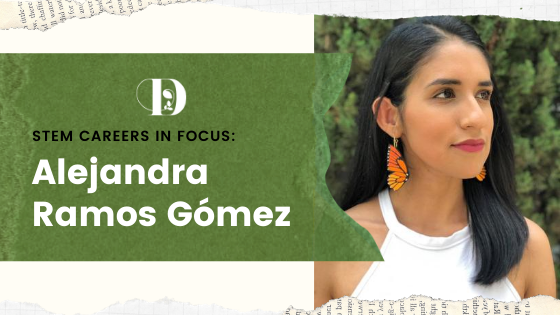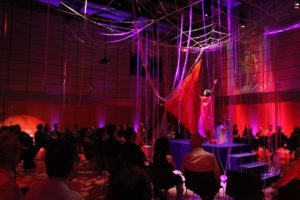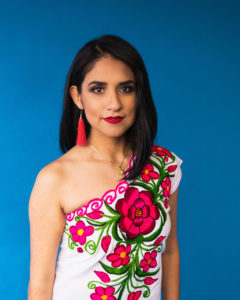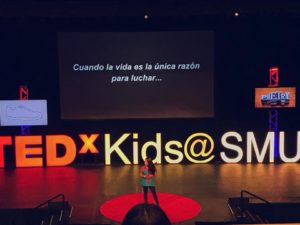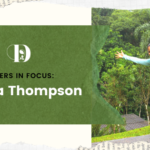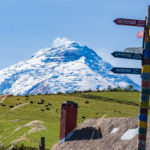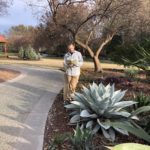STEM Careers in Focus: Alejandra Ramos Gómez
This week, we’re back with the second installment of our STEM Careers in Focus series. Director of Experience and Innovation Dustin Miller recently caught up with teacher, artist and activist Alejandra Ramos Gómez to chat about how she connects with kids and STEM.
Dustin Miller (DM): Alejandra, we’ve known each other for a few years now – ever since we both participated in the Galapagos Conservancy’s Education for Sustainability project representing SMU. What have you been up to since that time?
Alejandra Ramos Gómez (ARG): I have been fortunate to find a new teaching position that I love and [I’ve been] connect[ing] with local advocates to create experiences to share our art.
I am currently a dual language gifted and talented teacher at Walnut Hill Elementary in Dallas ISD, a Public Voices fellow of The OpEd Project, and an SEL fellow with United to Learn. I served as the co-host for Meet Me with Curiosity, a literary initiative with Klyde Warren Park, and was a featured artist on the AT&T’s Performing Arts Center Elevator Project. I have been finding more time to write bilingual texts, and I am happy to share that I am writing my first book of poetry to be released early next year!
DM: Tell me about your childhood and passion for artistic expression.
ARG: I grew up in the border city of Juárez, Mexico, and I attended multilingual schools with a focus on 21st-century skills. I was a very perfectionist and shy student, and I loved science and connecting to nature. I started dancing when I was six years old, and I really enjoyed it!
But it was not until I began to write and perform poetry when I was eight years old that I discovered my true passion. Oratory lessons were my safe space, and it was amazing to me to think that I could make people stop and listen to what I wanted to share. I joined my first theatre company when I was thirteen, and that is where I found my love for musical theatre.
DM: Could you share a bit more about your upbringing in a border town and the impact it has had on your teaching and art?
ARG: Living in the border is like living in both cultures at the same time. I grew up and studied on the Mexican side, but I was very aware of US culture, including TV shows, books and more. I learned English at an early age, and in my school, we were introduced to French in middle school and Mandarin Chinese in high school. This academic experience developed my love for linguistics and multilingualism. Learning another language helps us experience the world through multiple perspectives, and I am fascinated by the science behind it. Living in the border, I was unfortunately also exposed to high rates of violence. I learned early on that I had to be resilient, cautious, and speak up about bad things.
DM: Much of your work focuses on social issues. Can you explain your process a bit?
ARG: I would say almost all of it! I think it has to do a lot with my background living in the border and experiencing corruption and social injustice at an early age. As a gifted-and-talented student, I was always very aware of my surroundings, and I cared too much. I am first a listener; I like to hear other people’s perspectives and educate myself as much as I can before I speak about an issue. I ask questions and think through multiple perspectives. I guide all my work, whether it is academic or artistic, through equity and inclusion.
DM: You’ve said that you write to survive. That’s pretty intense, can you talk a bit more about this theme?
ARG: As a person who has always been very perfectionist and empathetic, I am very aware of how important it is to take care of my mental health. When I first moved to the US, I struggled with assimilation and loneliness, but poetry always felt safe. Whenever I am sad or anxious, I know writing will help me calm down and find power through my emotions. Poetry is one of those spaces where I do not have to follow any rules or conditions; I can be who I truly am.
DM: Our current Children’s Adventure Garden exhibit, Sounds of Science, examines the connections between the natural world and music. From your social media, I’ve seen you use music to connect with your students. Could you talk about this?
ARG: Yes! I love music because it is an excellent way to teach multiculturalism and help students develop empathy. I like introducing poetry through music lyrics because it helps them see that art is everywhere. My students enjoy learning about the different instruments around the world and the history behind their creation or popularity.
We also connect music to science because nature sounds inspire many instruments. They love the rain stick and the “tunkul,” the first Mayan instrument made from cedar. We learn about the concept of heritage and the stories of indigenous communities and their connection to musical instruments and mother nature.
DM: Social justice, conservation, and art seem to have significant opportunities for connection. What are your thoughts?
ARG: I agree! In my opinion, the connection is strengthening a community. If we teach students and children to develop their critical consciousness, they will be able to identify unfair situations and try to find a solution. When students are taught solidarity and empathy, they learn to respect each other and other living things. It helps them understand that we are interconnected in this world and that they can be social agents in their way. Once they have developed these skills, art serves as an excellent tool for them to express their feelings and to take action in their own way.
DM: Tell me about your work as a teacher and artist within STEM?
ARG: My approach to teaching STEM is through inquiry, authentic experiences, and empathy. When I teach math, I like to incorporate real-life situations and financial literacy components so that students can feel more identified. They also enjoy learning math in Spanish because they realize that math is the same across languages and borders! I help my students understand the interconnectedness and their role in this world.
Remote learning has been difficult, but it has also provided an opportunity to learn more about how to incorporate technology into our lessons, and my students love it. I like to provide opportunities for them to be creative, such as recording a video of a short story, coding, or even doing some animation.
DM: What is your primary goal as an educator? Artist?
ARG: As an educator, my primary goal is to teach students to create their own spaces and not to be afraid to be innovative! As an artist, my main goal is to advocate for the issues I am passionate about and create art that can heal and connect a community. As an educator and an artist, my goal is to instill a love for language and culture.
DM: How has art augmented your teaching practice?
ARG: It helps me see things through different lenses and to think out of the box. Students learn in many different ways, and incorporating art allows them to feel freer and find connections through different content areas. I love to sing, dance, do puppet shows, and paint with them. I like that it allows other children to shine; they can express themselves without stressing over a grade.
DM: Speaking of connecting with kids, tell me about your experience with TEDxKids@SMU and the Power of Spoken Word.
ARG: It was a beautiful experience! I had the honor to perform a TEDtalk about my experience as a poetry teacher in South Oak Cliff. I was able to talk to over 700 middle students about the power of identity and words. I shared a little bit about my experience growing up and how it helped me identify with my students. I also shared about our poetry open-mic and my students’ skills writing their poems. It was only my third year in this country, so it was terrific to have the opportunity to talk to a large group of students.
DM: So, how can parents use art to engage their kids in the natural world?
ARG: In my opinion, the best way to engage kids is by showing them that we care about it too. I talk to my kids about my love for living things, for example, by showing them art pieces that include nature and helping them understand that life has served as an inspiration to artists for a long time. For example, Remedios Varo, a surrealist Mexican artist, would paint cats. My students love to learn about her because they see that art can be unique and different. I think it is also essential to teach them to appreciate plants and animals and notice beauty in them. Families can also encourage them to recognize the colors and patterns that they see around them and learn how everything changes sooner or later. Even learning about constellations is something that they can connect to animals and artistic interpretation.
DM: How can your philosophy on art and expression help families to improve their experience in cultural sites like museums and gardens?
ARG: In my opinion, it is about trying to see beyond what others want you to see. It is super important to ask questions and allow our imagination to flow. Dialogic experiences are essential for children; they should feel heard and especially in these spaces. Whenever they ask questions, we can help them develop their curiosity by researching more back home and drawing their conclusions. It is also important to not force our interests on them but instead letting them find the things they are interested in and listening to their perspectives.
DM: Do you have any work(s) that you’d like to share with our Children’s Adventure Garden audience?
ARG: Yes! My last Op-Ed piece was published in Better, where I talk about how to talk to children about social justice. I also have an educational Facebook page where I share bilingual resources and videos.
You can follow Alejandra on Instagram or Twitter for more information – including news about her upcoming book!
Read our previous STEM Careers in Focus interviews:
Jungle Jordan: online science personality
Written by Dustin Miller, director of experience and innovation at the Dallas Arboretum
Related Posts
Comments are closed.


